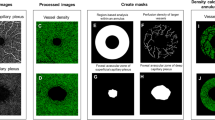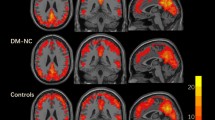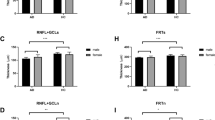Abstract
Purpose
The relationship between parameters of brain functional networks and clinical indexes is unclear so far in patients with diabetic retinopathy (DR). This paper is to investigate this.
Methods
Twenty-one patients with different grades of DR and 21 age- and sex-matched healthy controls were enrolled from August 2012 to September 2014. The clinical indexes recorded included DR grade, duration of diabetes, HbA1c, diabetic foot screen, fasting plasma glucose, insulin, Homa-β, Homa-IR, insulin sensitive index (ISI), Mini-Mental State Examination (MMSE), and patient sex and age. Subjects were scanned using 3-T MR with blood-oxygen-level-dependent and 3D–FSPGR sequences. MR data was analyzed via preprocessing and functional network construction, and quantified indexes of network (clustering coefficient, characteristic path length, global efficiency, degree distribution, and small worldness) were evaluated. Statistics consisted of ANOVA and correlation.
Results
There were significant differences between patients and controls among clustering coefficient, characteristic path length, degree distribution, and small worldness parameters (P < 0.05). MMSE scores negatively correlated with characteristic path length, and Hb1Ac negatively correlated with small worldness. MMSE, duration of diabetes, diabetic foot screen, fasting plasma glucose, insulin, Homa-β, Homa-IR, ISI, DR grade, and patient age, except from Hb1Ac, correlated with degree distribution in certain brain areas.
Conclusion
Brain functional networks are altered, specifically in the areas of visual function and cognition, and these alterations may reflect the severity of visual weakness and cognitive decline in DR patients. Moreover, the brain networks may be affected both by long-standing and instant clinical factors.


Similar content being viewed by others
References
Agarwal P, Jindal A, Saini VK (2014) Advances in diabetic retinopathy. Indian J Endocrinol Metab 18(6):772–777
Amaral LA, Scala A, Barthelemy M (2000) Classes of small-world networks. Proc Natl Acad Sci U S A 97(21):11149–11152
Antonetti DA, Klein R, Gardner TW (2012) Diabetic retinopathy. N Engl J Med 366(13):1227–1239
Bassett DS, Bullmore E, Verchinski BA (2008) Hierarchical organization of human cortical networks in health and schizophrenia. J Neurosci 28(37):9239–9248
Biessels GJ (2013) Sweet memories: 20 years of progress in research on cognitive functioning in diabetes. Eur J Pharmacol 719(1-3):153–160
Biessels GJ, Van Der Heide LP, Kamal A (2002) Ageing and diabetes: implications for brain function. Eur J Pharmacol 441(1–2):1–14
Bigbee J (2011) Precentral gyrus. In: Kreutzer JS, DeLuca J, Caplan B (eds) Encyclopedia of clinical neuropsychology. Springer, New York, p 1998
Cai S, Chong T, Zhang Y (2015) Altered functional connectivity of fusiform gyrus in subjects with amnestic mild cognitive impairment: a resting-state fMRI study. Front Hum Neurosci 9:471
Chen Z, Li L, Sun J (2012) Mapping the brain in type II diabetes: voxel-based morphometry using DARTEL. Eur J Radiol 81(8):1870–1876
Chen Y, Liu Z, Zhang J (2015) Selectively disrupted functional connectivity networks in type 2 diabetes mellitus. Front Aging Neurosci 7:233
Chen Z, He Y, Yu Y (2016) Enhanced functional connectivity properties of human brains during in-situ nature experience. PeerJ 4:e2210
Crosby-Nwaobi R, Sivaprasad S, Forbes A (2012) A systematic review of the association of diabetic retinopathy and cognitive impairment in people with type 2 diabetes. Diabetes Res Clin Pract 96(2):101–110
Dai H, Morelli JN, Ai F (2013) Resting-state functional MRI: functional connectivity analysis of the visual cortex in primary open-angle glaucoma patients. Hum Brain Mapp 34(10):2455–2463
Hayashi K, Kurioka S, Yamaguchi T (2011) Association of cognitive dysfunction with hippocampal atrophy in elderly Japanese people with type 2 diabetes. Diabetes Res Clin Pract 94(2):180–185
Kaas JH (2015) Somatosensory cortex A2—toga. In: Arthur W (ed) Brain mapping. Academic Press, Waltham, pp 283–286
Kawamura T, Umemura T, Hotta N (2015) Curious relationship between cognitive impairment and diabetic retinopathy. J Diabetes Investig 6(1):21–23
Kim DJ, Yu JH, Shin MS (2016) Hyperglycemia reduces efficiency of brain networks in subjects with type 2 diabetes. PLoS One 11(6):e0157268
Klein BE (2007) Overview of epidemiologic studies of diabetic retinopathy. Ophthalmic Epidemiol 14(4):179–183
Li W, Li Y, Hu C (2014) Point process analysis in brain networks of patients with diabetes. Neurocomputing 145:182–189
Mears D, Pollard HB (2016) Network science and the human brain: using graph theory to understand the brain and one of its hubs, the amygdala, in health and disease. J Neurosci Res 94(6):590–605
Nathan DM, Zinman B, Cleary PA (2009) Modern-day clinical course of type 1 diabetes mellitus after 30 years’ duration: the diabetes control and complications trial/epidemiology of diabetes interventions and complications and Pittsburgh epidemiology of diabetes complications experience (1983–2005). Arch Intern Med 169(14):1307–1316
Ozsoy E, Doganay S, Dogan M (2012) Evaluation of metabolite changes in visual cortex in diabetic retinopathy by MR-spectroscopy. J Diabetes Complicat 26(3):241–245
Park HJ, Friston K (2013) Structural and functional brain networks: from connections to cognition. Science 342(6158):1238411
Pickles JO (2012) An introduction to the physiology of hearing, 4th edn. Emerald Group Publishing Limited, Bingley, pp 215–217
Ruben J, Schwiemann J, Deuchert M (2001) Somatotopic organization of human secondary somatosensory cortex. Cereb Cortex 11(5):463–473
Van Den Berg E, Reijmer YD, De Bresser J (2010) A 4 year follow-up study of cognitive functioning in patients with type 2 diabetes mellitus. Diabetologia 53(1):58–65
Van Den Heuvel MP, Sporns O (2013) Network hubs in the human brain. Trends Cogn Sci 17(12):683–696
Van Duinkerken E, Schoonheim MM, Sanz-Arigita EJ (2012) Resting-state brain networks in type 1 diabetic patients with and without microangiopathy and their relation to cognitive functions and disease variables. Diabetes 61(7):1814–1821
Wang ZL, Zou L, Lu ZW (2017) Abnormal spontaneous brain activity in type 2 diabetic retinopathy revealed by amplitude of low-frequency fluctuations: a resting-state fMRI study. Clin Radiol 72(4):340.e341–340.e347
Warrier C, Wong P, Penhune V (2009) Relating structure to function: Heschl’s gyrus and acoustic processing. J Neurosci 29(1):61–69
Williams R, Airey M, Baxter H (2004) Epidemiology of diabetic retinopathy and macular oedema: a systematic review. Eye (Lond) 18(10):963–983
Yau JW, Rogers SL, Kawasaki R (2012) Global prevalence and major risk factors of diabetic retinopathy. Diabetes Care 35(3):556–564
Yoon H, Jeon DJ, Park CE (2016) Relationship between homeostasis model assessment of insulin resistance and beta cell function and serum 25-hydroxyvitamin D in non-diabetic Korean adults. J Clin Biochem Nutr 59(2):139–144
Zachariah S, Wykes W, Yorston D (2015) Grading diabetic retinopathy (DR) using the Scottish grading protocol. Community Eye Health 28(92):72–73
Zlokovic BV (2008) The blood-brain barrier in health and chronic neurodegenerative disorders. Neuron 57(2):178–201
Author information
Authors and Affiliations
Corresponding authors
Ethics declarations
Funding
This work was primarily funded by the National Natural Science Foundation of China (Grant 81201079), partially funded by Medical Research Projects of the Department of Health, Jiangsu Province (Grant Q201303) and partially funded by the Jiangsu Provincial Department of Education (Grant JS-2014-197).
Conflict of interest
The authors declare that they have no conflict of interest.
Ethical approval
All procedures performed in studies involving human participants were in accordance with the ethical standards of the institutional and/or national research committee and with the 1964 Helsinki declaration and its later amendments or comparable ethical standards.
Informed consent
Informed consent was obtained from all individual participants included in the study.
Rights and permissions
About this article
Cite this article
Dai, H., Zhang, Y., Lai, L. et al. Brain functional networks: correlation analysis with clinical indexes in patients with diabetic retinopathy. Neuroradiology 59, 1121–1131 (2017). https://doi.org/10.1007/s00234-017-1900-5
Received:
Accepted:
Published:
Issue Date:
DOI: https://doi.org/10.1007/s00234-017-1900-5




